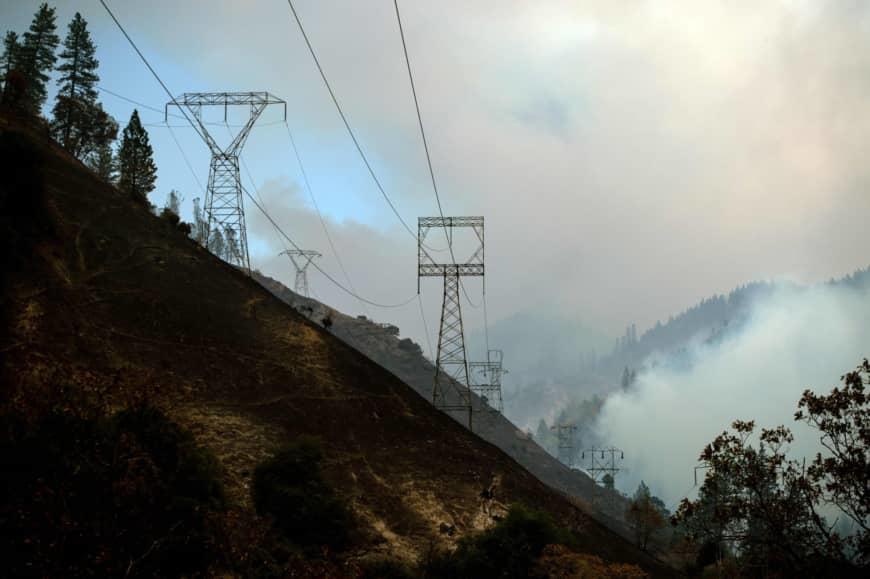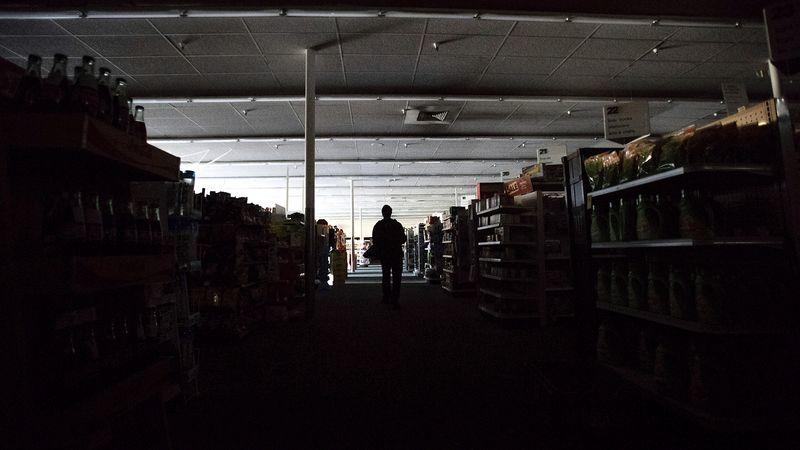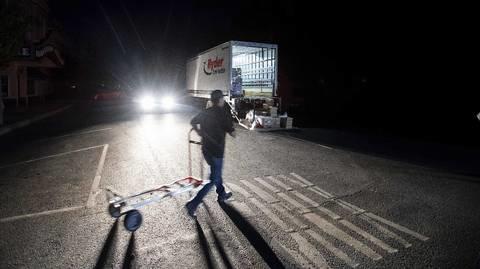"This Is The Third World": Up To 3 Million Californians To Lose Power As PG&E Begins "Unprecedented" Blackouts
10/09/2019
As previewed last night, PG&E Corp., California's largest (bankrupt) utility, began shutting off power Wednesday to an unprecedented 3 million people in Northern California in the face of hot, windy weather that raises the risk of wildfires. While the high winds are forecast to subside by late Thursday, the company will undertake extensive inspections of its equipment before turning electricity back on, meaning outages could persist into next week. More than 3 million people may be eventually affected, based on city estimates and the average household size. The economic impact may reach $2.6 billion.
Half a million homes and businesses in Northern California have already lost power as PG&E orchestrates the biggest-ever intentional power shutoff to keep its lines from sparking blazes. The company was scheduled to shut service to another 234,000 customers in cities including Berkeley and Oakland at noon local time, but told city and county officials that those cutoffs will instead start Wednesday evening. Strong, dry winds that heighten the risk of wildfires are picking up later than forecast, the company said.
According to Bloomberg, never before have California utilities intentionally cut power to so many people for their own safety - and never has a shutoff affected such major metropolitan areas, even as the city of San Francisco and Silicon Valley appear spared. The undertaking is key to fairly new strategy by PG&E for preventing power lines from sparking another deadly - and costly - conflagration.
“This is unprecedented in terms of what all of us are facing as a community,” PG&E Vice President Sumeet Singh said at a media briefing Tuesday night. “We are doing everything we can to minimize the impact on our customers’ lives.”
The shutoff was scheduled to occur in three phases, eventually affecting almost 800,000 homes and businesses, including in the San Francisco Bay Area and Napa County. The next phase will include parts of Alameda, Contra Costa, Santa Clara and Santa Cruz counties, among others. The utility will also turn off 21,800 customers in Mendocino and Calaveras counties who didn’t lose power during the first stage.
After that, PG&E will weigh a third one for the southernmost portions of its service area, affecting 42,000. In all, about 15% of the utility’s customers may go dark.
The bankrupt Pacific Gas & Electric, which announced the deliberate outage, is working to prevent a repeat of a catastrophe last November in which faulty power lines it owned were determined to have sparked California’s deadliest wildfire in modern history. California Gov. Gavin Newsom said the “frustration that Californians feel as they deal with the impacts of these power outages is warranted,” but that safety was the main concern.
“The biggest threat looks to be today and continuing into the day tomorrow,” Marc Chenard, a senior branch forecaster with the U.S. Weather Prediction Center in College Park, Maryland, said of the fire risk.

“Our first priority is to protect people and to ensure that communities are safe,” the governor said in a statement.
In last year’s inferno, 86 people died and a town called Paradise was virtually destroyed. PG&E has been found responsible for dozens of other wildfires in recent years, too. This is peak wildfire season in California.
With large portions of the San Francisco Bay area set to be affected - including cities such as Oakland, Berkeley and San Jose - the shutdowns are a test for a densely populated region that’s the hub of the U.S. technology industry.
“Extremely critical” fire conditions were expected in parts of Northern California Wednesday, and in Southern California around Los Angeles county Thursday, the National Weather Service said. PG&E said the severe weather incident prompting its precautionary shutoffs — hot, dry conditions and winds gusting at up to 70 mph (110 kph) — was expected to last through mid-day Thursday in northern and central California.
Near Los Angeles, Edison International’s Southern California Edison utility said it was also considering cutting power to almost 174,000 homes and businesses. Sempra Energy’s San Diego Gas & Electric warned that it could shut power to about 30,000 customers within the next two days

The outages already affecting regions such as the Napa Valley wine country could last up to a week in some places. There was some last minute good news: PG&E briefly put off the next round of unprecedented blackouts across Northern California for a few hours on Wednesday after weather forecasts took a turn for the better. However, they were still expected to kick in later in the day.
The turn in weather forecasts hasn’t yet changed how many customers are set to lose power according to Bloomberg. Utilities in the Los Angeles and San Diego areas were also warning of service cuts.
While the city of San Francisco is not affected by the intentional shutoff - after all the locals have to be able to see when they are about to walk into human shit - much of the surrounding Bay Area could go dark, including parts of Silicon Valley. A prolonged outage threatens to roil the region’s economy by disrupting workers and everyday life.
“If you lose power for five hours, you may have to throw out some milk,” said Michael Wara, director of the Climate and Energy Policy Program at Stanford University. “If you lose power for five days, you need to throw anything that’s perishable away, and you are likely eating out of a can.”
Officials in Malibu — the glitzy home to Hollywood stars, which was also struck by last year’s inferno — said power company Southern California Edison had warned of another possible shutoff in areas from late Thursday through Friday.
More than 100,000 customers could lose power across eight Southern California counties, SCE said. Schools and universities closed Wednesday and people stocked up on gasoline, water, batteries and other basics.
“Early indicators are that the campus outage will last up to 48 hours,” said University of California, Berkeley, announcing all classes were canceled. The irony that this is taking place at the West Coast mecca of socialist thought was not lost on anyone.
With frustration rising, California state Sen. Jerry Hill described the mass blackouts as “excessive” in their scale.
“This cannot be something that can be acceptable nor long-term,” Hill told the Los Angeles Times. “This is third world, and we are not,” he added.
Daniel Swain, a climate scientist at UCLA in Los Angeles, tweeted that the power shutoffs were “a necessary bad idea in the short term” that shifts the financial costs from the power companies to the public.
As we reported last night, the first part of PG&E power cuts began midnight Tuesday into Wednesday in northern California. It affected more than 500,000 customers there, the utility company said.

The rest of the San Francisco Bay area was to start losing power in waves around noon local time. A possible third phase could take place later in the day farther south.
PG&E said it expected to start turning the power back on Thursday but can only do so after inspecting its equipment for damage, which could take days in some areas.
Unfortunately for customers, PG&E won’t be able to switch the power back on once the winds stop. Crews must inspect every inch of lines to ensure they’re safe to carry electricity again. Cities have warned residents to brace for six days without power. “It’s not just a matter of, ’red flag’s over, I can turn the lights back on,”’ said Gregg Edeson, a utility consultant. “The utility really does have to go out there and look.”
The utility that supplies water to much of the East Bay has rented backup generators for its pumping stations and plants, at a cost of $400,000 for the season. But the fuel to run those generators could cost $75,000 per outage, said Andrea Pook, spokeswoman for the East Bay Municipal Utility District. And the district is still asking customers to conserve water, limiting the need for the generators.
“As an insurance policy, we’re asking customers to be mindful,” she said.
PG&E’s warnings gave residents and businesses time to prepare, said Joe Eto, a Lawrence Berkeley National Laboratory staff scientist. Many companies, he said, can now have employees work remotely, conducting business through the cloud if needed. And if their own homes go dark, there are other places they can take their laptops to charge up and work.
“Never underestimate the resourcefulness of people under stress,” he said. Then again, this is California...
https://www.zerohedge.com/personal-finance/third-world-3-million-californians-lose-power-pge-begins-unprecedented-blackouts

沒有留言:
發佈留言